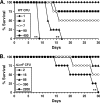Small molecule inhibitors of LcrF, a Yersinia pseudotuberculosis transcription factor, attenuate virulence and limit infection in a murine pneumonia model
- PMID: 20823209
- PMCID: PMC2976336
- DOI: 10.1128/IAI.01305-09
Small molecule inhibitors of LcrF, a Yersinia pseudotuberculosis transcription factor, attenuate virulence and limit infection in a murine pneumonia model
Abstract
LcrF (VirF), a transcription factor in the multiple adaptational response (MAR) family, regulates expression of the Yersinia type III secretion system (T3SS). Yersinia pseudotuberculosis lcrF-null mutants showed attenuated virulence in tissue culture and animal models of infection. Targeting of LcrF offers a novel, antivirulence strategy for preventing Yersinia infection. A small molecule library was screened for inhibition of LcrF-DNA binding in an in vitro assay. All of the compounds lacked intrinsic antibacterial activity and did not demonstrate toxicity against mammalian cells. A subset of these compounds inhibited T3SS-dependent cytotoxicity of Y. pseudotuberculosis toward macrophages in vitro. In a murine model of Y. pseudotuberculosis pneumonia, two compounds significantly reduced the bacterial burden in the lungs and afforded a dramatic survival advantage. The MAR family of transcription factors is well conserved, with members playing central roles in pathogenesis across bacterial genera; thus, the inhibitors could have broad applicability.
Figures






References
-
- Anisimov, A. P., and K. K. Amoako. 2006. Treatment of plague: promising alternatives to antibiotics. J. Med. Microbiol. 55:1461-1475. - PubMed
-
- Bieber, D., S. W. Ramer, C.-Y. Wu, W. J. Murray, T. Tobe, R. Fernandez, and G. K. Schoolnik. 1998. Type IV pili, transient bacterial aggregates, and virulence of enteropathogenic Escherichia coli. Science 280:2114-2118. - PubMed
Publication types
MeSH terms
Substances
Grants and funding
LinkOut - more resources
Full Text Sources

